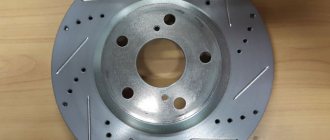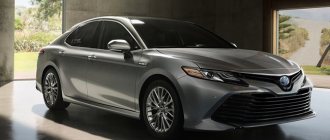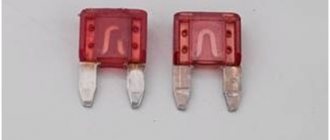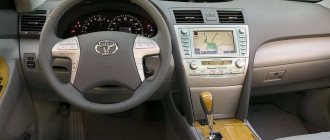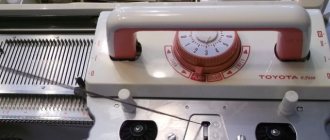CAMRY_019
It is thanks to its unprecedented reliability that Camry is in demand in Russia. Even a used one, it will delight you with low maintenance costs, high liquidity and excellent maintainability.
In our secondary market, dealer versions predominate, since since 2008, the assembly of sedans has been established in Russia. We officially sold sedans with increased ground clearance and adapted suspension. The basic Comfort version (with a 2.4 engine) had six airbags, power accessories, dual-zone climate control and an audio system with a six-disc CD changer. The Comfort Plus version was complemented by a 5-speed automatic transmission. The Elegance option included a parking radar and leather seats (front ones with electric drive). The Prestige package included cruise control, stability control and xenon headlights. And the top-end Luxury, among other things, was equipped with a V6 engine and a 6-speed automatic transmission.
Restyling
From the history of the model
ON THE CONVEYOR:
from 2011 to 2021
BODY:
sedan
RUSSIAN RANGE OF ENGINES:
petrol, P4, 2.0 l (148 and 150 hp);
2.5 l (181 hp); V6, 3.5 l (277 and 249 hp) GEARBOXES:
A4, A6
DRIVE:
front
RESTYLING:
2014 - update of head lighting equipment, lights, radiator grille, hood, trunk lid, front and rear bumpers;
the center console, steering wheel and instrument panel have been refreshed; new design and materials of some interior trim elements; the range of engines and gearboxes has been revised: the four-speed automatic has been eliminated, instead of the 2.0 1AZ series engine (148 hp), a more recent 2.0 6AR engine (150 hp) has appeared. CRASH TESTS:
2012, ANCAP; overall score - (36.59 out of 37 points): frontal impact - 15.59 out of 16 points, side impact - 16 out of 16 points
CAMRY_129
Engines: two engines, but which ones...
Toyota Camrys officially sold in Russia were equipped with only gasoline engines: a 2.4-liter four (167 hp) and a 3.5-liter V6 (277 hp). Both engines are equipped with a timing chain with a proprietary VVT-i phase control system. The valves of power units are regulated by selecting washers, but this operation is required after 150 thousand km. But the officials carry out maintenance every 10 thousand kilometers. Among the recurring malfunctions, one can highlight the generator pulley turning at 100 thousand km. At the same time, the generator itself lasts one and a half times longer, and the pulley is replaced separately. Both engines prefer synthetic oil. Otherwise, the VVT-i system clutch will fail prematurely. It is recommended to wash the throttle body once every 30–40 thousand km so as not to replace the unit ahead of schedule. Oxygen and mass air flow sensors fail due to surrogate fuel.
On “fours”, the engine and air conditioner radiators need to be cleaned every two years. Otherwise, the cylinder head will “drive” due to overheating. By 100 thousand km, the drive belt tensioner usually wears out. And the imminent death of the water pump is indicated by traces of antifreeze under the hood and increased noise from the pump.
On a V6, at 150 thousand km, individual ignition coils begin to “burn” one after another - the time has come. But the main problem is oil leakage due to a leaky oil cooler pipe. Since 2009, the oil line became all-metal, and the problem went away. The company conducted a recall campaign on this topic.
Used Toyota Camry XV40: corrosion, interior wear, electrical glitches
Camry: origin of the species
In the mid-90s, only E-class cars were considered business class, but by the beginning of the 2000s, the classification had lost its way.
There are simply no “non-premium” cars of this class left, but the D-class has grown in size so much that at first it was called D+, and then it turned out that it is most convenient to call this class of cars “mid-size or business class,” by analogy with the American classification . So everyone understands what we are talking about. In Russia, large, but not particularly “premium” cars were bought for personal use, for corporate fleets, and for the needs of middle and senior officials. Today we will talk about a car that for a long time became the face of the class and the best-selling car among its kind in Russia for many years - the Toyota Camry in its sixth generation, that is, in the XV40 body.
Pictured: Toyota Camry (XV40) '2006–11
The model was produced from 2006 to 2011, and for us it is interesting because its success forced Toyota to open production near St. Petersburg. According to the current localization standards, this is a “domestic” car, which is clearly visible from all kinds of government purchases and the abundance of these sedans at various federal buildings.
Why buy Camry?
What is the reason for such success? It's unlikely that it's a matter of the car's appearance. She is quite “Central Asian”, although quite characteristic. It doesn't have the most luxurious interior. And in terms of technology, the car is not at all surprising - everything is simple and standard: naturally aspirated engines, simple automatic transmissions. Except that the MacPherson strut suspension instead of a multi-link at the rear can generally be considered a curiosity, but for Toyota this is just typical.
Pictured: Toyota Camry '2006–09
The secret is a combination of reliability and brand image, comfort and the manufacturer’s successful pricing policy. And, of course, in localization and government procurement. The car itself is not much, but it is better than all its competitors on average: it does not have too cheap equipment, like the Mondeo , the design is calmer than the Teana, and the quality of the main units is excellent.
These cars have very few serious problems - that's the honest truth. And the quality of service is also higher than that of other brands - Toyota still does not support “pseudo-ecological” standards for increasing maintenance intervals, obliging owners to change the engine oil, filters and other consumables every 10 thousand.
There are still enough people willing to buy a reliable car, which is why prices are kept at a very high level. At the moment, a ten-year-old Camry is at least a third more expensive than its classmates, and even premium European E-Class cars of the same age.
Pictured: Toyota Camry LE '2009–11
Of course, at first glance it is strange that someone would prefer a Toyota to a Mercedes in the 211 body, but if you look at the number of problems that await a typical buyer and the planned costs, everything falls into place. Mercedes, taking into account operating costs for a couple of years, will end up being more expensive, and noticeably so. So everything is correct: Toyota is bought by those who are thrifty, and Mercedes is bought by those who can afford it. Or is it not that simple?
Let's take a closer look at the nuances of the design, because the first cars have already passed the ten-year threshold, which by the standards of any brand is a respectable age, and the youngest cars of this generation are already over five years old. Let's say that some used Germans at this age manage to cause a lot of expensive problems. But Toyota is different.
Body
There are no questions about the quality of the anti-corrosion treatment for the Camry. Well, or almost not. Rarely do any examples have slight blistering of the paint on the hood or on the edges of the doors. According to most owners, this is a real nightmare and horror. In fact, quite typical little things in life.
The paint job itself is not that perfect, the paintwork is easily rubbed off by the age of five, and the front end suffers from numerous chips and abrasions. Wide bumpers are especially hard on them - on their smooth surface all defects are clearly visible. In general, many people cover the entire front with “armored film” or paint it with “ceramics” - a particularly durable varnish.
Pictured: Toyota Camry LE '2009–11
An even more rare occurrence is corrosion at the edges of the arches. It occurs on cars from Moscow or St. Petersburg, with very high mileage and banal “sandblasting” and poor maintenance. Practice shows that these are not necessarily cars after an accident and body repairs: if you don’t give a damn, even a Toyota body at that age will be far from in ideal condition.
Front wing
price for original
12,180 rubles
What saves you is the good quality of dealer service, a warranty on the paintwork and, oddly enough, the high residual price of the cars. After all, deciding to paint a car that costs 700 thousand rubles is much easier than a car that costs about 300 thousand. The cost of the operation is approximately the same in both cases, but the increase in cost varies dramatically.
If you look more carefully, you will also find corrosion of the subframes, a slight violation of the seam sealant in the area of the front floor members and the engine compartment. Possibly clogged drains in the windshield niche and all sorts of small things.
But in general, the condition differs for the better from all cars of comparable age. If we talk about bodies, then only Opel Vectra C, Volvo S60 and S80, Audi before 2008, and even BMW are at a similar or slightly lower level among cars comparable in class. Nowadays, this level of anti-corrosion protection is not in fashion.
Pictured: Toyota Camry '2009–11
Front bumper
price for original
19,584 rubles
True, the Japanese approach, unfortunately, does not provide for stainless fasteners and decorative elements resistant to road chemicals. All the “chrome” and various bolts and nuts under the hood and bottom of the car peel off and become covered with rust on a common basis. They solve problems in different ways. Someone paints over the chrome and does not pay attention to the difficulties with maintaining the suspension due to corroding fasteners, someone replaces the elements with new or “contract” ones and anti-corrodes everything down to the smallest detail. To the credit of the owners, the last option of maintenance is quite typical; fans of reliability go to extra expenses to preserve it.
The list of unpleasant little things with the body does not end there. The lower “lip” of the front bumper on pre-restyling cars is a typical place for repairs. An unsuccessful design is broken by any unfortunate contact with curbs or snowdrifts; failure is especially common when reversing. On many cars, this part of the bumper has been repaired and strengthened, sometimes even more than once. Replacing a bumper with a restyled one is much more expensive than repairs, and usually these are the consequences of a more serious impact. The “question price” is more than 60 thousand rubles, and includes the replacement of the bumper, head optics, fog lights and many additional elements.
The door handles are weak and the paint is peeling off. In winter you need to be careful; when the door freezes, you should not pull with all your might. The windshield is quite soft, and by the mileage of 100 thousand it can be quite worn out. Like the front optics - but it is mainly damaged by the burnout of the headlight reflectors, and not by the cloudy glass.
There are simply no really serious and regular problems. This is reflected in the very careful elaboration of almost all elements. When you examine the car, you understand why it is so valued. All vulnerable spots are covered very carefully. The mating of the bumpers and fenders is made in such a way that friction is almost eliminated even with careless installation. The plastic of the thresholds and lockers is quite soft, can withstand stones and is carefully secured. The tightness of the design is thought out to the smallest detail - the drains do not get dirty, moisture from above does not get into the internal cavities, the drainage is made with a good margin and does not get dirty reluctantly, unless you constantly park the car under trees in the fall.
Pictured: Toyota Camry '2006–09
However, do not be surprised that the owners of the previous Camry in the XV30 body consider this car not particularly reliable, and the body is ill-conceived. After all, the paintwork becomes cloudy, the door limiters click, the mirrors break on impact, and it’s impossible to polish out the scratch. In general, the ideal of “real imperial quality” is still (or rather, already) far away.
Salon
The interior is a little more difficult than the body. The interior, which is quite pleasant at first glance, shows with age the lack of quality of materials and the peeling off of the ubiquitous “silver”, the leather wrinkles, and the fabric gets dirty and loses its appearance. And “wood” in practice turns out to be not a very resistant water print to our temperatures, and the varnish often peels off and wears out.
By the mileage of 200 thousand, the interior retains its pristine silence only if new original fasteners are used for any work, careful reinforcement work is performed during maintenance and replacement of wearable elements such as seals. The abundance of large plastic parts in the door trim and especially the huge rear parcel shelf do not contribute to silence at all.
Pictured: Toyota Camry XLE '2006–09 interior
Typical troubles after a hundred to one and a half thousand mileage are squeaks in the glove box and center console. In specialized services, problems of this kind can be easily cured. There are also such unpleasant little things as rattling of door handles, steering shaft or interior mirror. It is not easy to detect them - the driver thinks that the sound is coming from somewhere in the right corner of the front panel or from under it, but it is difficult to localize the problem on the spot, and it is not possible while driving.
1 / 5
2 / 5
3 / 5
4 / 5
5 / 5
Wide seats with such a mileage are noticeably deformed, and if the driver is heavy, then the driver’s seat takes on a frankly worn-out look by one and a half hundred thousand miles. The power adjustments usually work reliably, but the driver's seat harness contact sometimes causes an airbag error. By the way, after 60-70 thousand mileage, for drivers who “steer” especially hard, a similar effect is caused by the wear of the steering wheel cable, but more often this manifests itself as failure of the buttons on it.
Pictured: Toyota Camry LE '2009–11 interior
Failure of the power window unit is not uncommon; there was even a recall campaign for it. If the glass rises up and then stubbornly drops halfway, then do not rush to fix the defect yourself - check with the dealer to see if your car is subject to a recall. You can also get new floor mats and new fastenings from the dealer as part of the same recall campaign - the driver's floor mat can fix the gas pedal when pressed, which, of course, is very dangerous. Don't want to go to the dealer? Better secure the carpets better, and trim the area near the gas pedal. Many aftermarket rugs are still made from the old patterns and suffer from the same problem.
1 / 4
2 / 4
3 / 4
4 / 4
The list of problems is mostly “cosmetic” - it can be considered exemplary behavior for a car of this class. The quality of sound insulation and materials does not reach the standards set by the German “premium”, but the level of comfort is more than sufficient, and all this is easy to repair, change and maintain.
Electrical and electronics
If it weren't for the generator, there would be no serious shortcomings. However, our and Japanese-made cars have an overrunning clutch in the generator drive, which sometimes cannot withstand hundreds of thousands of mileage. The unpleasant noise during operation and the flying belt of the drive of additional units are on her conscience. However, no one is stopping you from replacing it with a solid pulley from American cars. The resource of the generator itself before replacing the brushes is usually about 150 thousand, but the operation is simple and inexpensive.
Pictured: Toyota Camry XLE '2006–09
Discharge headlight
price for original
22,209 rubles
On cars with a 2.4 engine, where a 4-speed automatic transmission is installed, failures of the selector occur, which refuses to shift. Most often, the problem can be easily resolved by simply disassembling it and cleaning or replacing the brake pedal sensor. Another option is a failure of the locking motor, which is activated in the Parking position. If it stops working, you will not switch out of “parking”. The motor is inexpensive to replace, and especially thrifty owners simply remove the locking pin.
There are no complaints about the wiring: it is made extremely simply, and there are almost no weak points. Only the trunk lid harness can fray; all other parts are holding up perfectly. And also, if additional noise and vibration insulation , they could remove numerous points of attachment of the internal harnesses to the body panels, which usually over time provokes chafing of the “corrugation”, and then the wires themselves.
An unpleasant feature of the Camry is the open location of the ECU - the engine control unit. When it is stolen, this is the main drawback: literally within thirty seconds it is replaced with a “stitched” one, and the car drives away. In addition to replacing the block, there is also a method of flashing new keys - unfortunately, this is also a quick operation due to software vulnerabilities. So, in addition to protecting the engine compartment and the control unit itself, it is recommended to remove the OBD II diagnostic connector from its regular place.
Pictured: Toyota Camry '2006–09
Of course, a bunch of alarms and immobilizers are the Camry’s eternal companions, which negatively affect the reliability of its electrical circuits. When purchasing, it is recommended to check whether the owner has a map for installing various secrets, whether there are any “ambushes” such as resoldering the ECU connector to prevent its replacement and other issues that could dramatically complicate the life of the new owner in the future.
What else?
It seems that everything is not bad at all: the electrics are very simple, the body is preserved with dignity, except that the interior can let us down. What about the main units? We'll tell you in the next part . Oddly enough, the Camry has at least one serious pitfall in the “face” of the 3.5 engine.
CAMRY_315
Chassis and steering
Traditional durability
The Camry's fully independent suspension is durable. The first to wear out are the stabilizer bushings, which often last up to 80 thousand km. And the remaining elements are even long-lived: front control arms (5,800 rubles) are replaced closer to 130 thousand km due to wear of the silent blocks, and ball joints (2,000 rubles each) and shock absorbers (6,500 rubles each) are maintained until 200 thousand km The rear wishbones and shock absorbers can also last 200 thousand km. A complete overhaul of the rear suspension will cost 20,000 rubles.
In steering, on average, steering rods can withstand 130 thousand km (1,800 rubles each). And the rail itself will easily survive the 200,000th milestone. But the steering shaft universal joint wears out ahead of schedule, and the oil seals and high-pressure hose of the power steering pump may also leak.
In the braking system, the front discs (4,500 rubles each) often warp from overheating, and by 100 thousand km the calipers become sour, which are recommended to be lubricated at every maintenance.
Diagnostics of Toyota Camry.
Before buying a used Toyota Camry, you need to start by checking the legal purity. The body number is located on the passenger side. Additional markings are located on the body pillar on the driver's door side. Checking the body numbers for “authenticity” must be done by a forensic expert. Secondary coloring of body elements is allowed, but its geometry should not be disturbed - try to avoid cars after serious accidents.
Suspension parts have a service life of over 100,000 km.
For cars with a V6 engine, close attention should be paid to the condition of the automatic transmission and engine. You may be expected to invest in brake system maintenance - check the wear of the discs and pads. There may also be investments in the suspension, but the price of spare parts and labor will not upset you. With a mileage of over 200,000 km, the steering rack may become “fogged” - this is normal. You should monitor the power steering fluid level and the integrity of the steering rack boots. Cars with a minimum configuration were often used as “traveling” vehicles in commercial structures and taxis, which are characterized not only by high mileage, but also by prolonged idling of the engine - hence the increased load and wear of the mechanisms.
There is some surface corrosion of the body in the rear. Years of use take their toll.
Fuel pipes and the neck of the fuel tank suffer from corrosion.
In general, buying a used Toyota Camry in the 40 body is quite justified and an executive business sedan in good condition will please you for many years.
CAMRY_044
Are we buying?
It’s not at all easy to find a second car that can compete with the Toyota Camry in reliability and durability. Therefore, the liquidity of the model on the Russian market is very high - the cheapest copy now costs 530,000 rubles. However, it is better to add another hundred and a half and look for a restyled version produced in 2009 or younger - sedans of this age have practically no weak points.
Toyota Camry V40: bride of convenience
